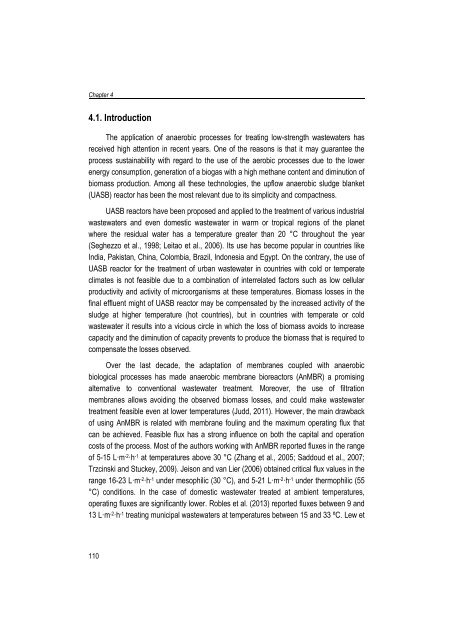Combining submerged membrane technology with anaerobic and ...
Combining submerged membrane technology with anaerobic and ...
Combining submerged membrane technology with anaerobic and ...
Create successful ePaper yourself
Turn your PDF publications into a flip-book with our unique Google optimized e-Paper software.
Chapter 44.1. IntroductionThe application of <strong>anaerobic</strong> processes for treating low-strength wastewaters hasreceived high attention in recent years. One of the reasons is that it may guarantee theprocess sustainability <strong>with</strong> regard to the use of the aerobic processes due to the lowerenergy consumption, generation of a biogas <strong>with</strong> a high methane content <strong>and</strong> diminution ofbiomass production. Among all these technologies, the upflow <strong>anaerobic</strong> sludge blanket(UASB) reactor has been the most relevant due to its simplicity <strong>and</strong> compactness.UASB reactors have been proposed <strong>and</strong> applied to the treatment of various industrialwastewaters <strong>and</strong> even domestic wastewater in warm or tropical regions of the planetwhere the residual water has a temperature greater than 20 °C throughout the year(Seghezzo et al., 1998; Leitao et al., 2006). Its use has become popular in countries likeIndia, Pakistan, China, Colombia, Brazil, Indonesia <strong>and</strong> Egypt. On the contrary, the use ofUASB reactor for the treatment of urban wastewater in countries <strong>with</strong> cold or temperateclimates is not feasible due to a combination of interrelated factors such as low cellularproductivity <strong>and</strong> activity of microorganisms at these temperatures. Biomass losses in thefinal effluent might of UASB reactor may be compensated by the increased activity of thesludge at higher temperature (hot countries), but in countries <strong>with</strong> temperate or coldwastewater it results into a vicious circle in which the loss of biomass avoids to increasecapacity <strong>and</strong> the diminution of capacity prevents to produce the biomass that is required tocompensate the losses observed.Over the last decade, the adaptation of <strong>membrane</strong>s coupled <strong>with</strong> <strong>anaerobic</strong>biological processes has made <strong>anaerobic</strong> <strong>membrane</strong> bioreactors (AnMBR) a promisingalternative to conventional wastewater treatment. Moreover, the use of filtration<strong>membrane</strong>s allows avoiding the observed biomass losses, <strong>and</strong> could make wastewatertreatment feasible even at lower temperatures (Judd, 2011). However, the main drawbackof using AnMBR is related <strong>with</strong> <strong>membrane</strong> fouling <strong>and</strong> the maximum operating flux thatcan be achieved. Feasible flux has a strong influence on both the capital <strong>and</strong> operationcosts of the process. Most of the authors working <strong>with</strong> AnMBR reported fluxes in the rangeof 5-15 L·m -2·h -1 at temperatures above 30 °C (Zhang et al., 2005; Saddoud et al., 2007;Trzcinski <strong>and</strong> Stuckey, 2009). Jeison <strong>and</strong> van Lier (2006) obtained critical flux values in therange 16-23 L·m -2·h -1 under mesophilic (30 °C), <strong>and</strong> 5-21 L·m -2·h -1 under thermophilic (55°C) conditions. In the case of domestic wastewater treated at ambient temperatures,operating fluxes are significantly lower. Robles et al. (2013) reported fluxes between 9 <strong>and</strong>13 L·m -2·h -1 treating municipal wastewaters at temperatures between 15 <strong>and</strong> 33 ºC. Lew et110
















